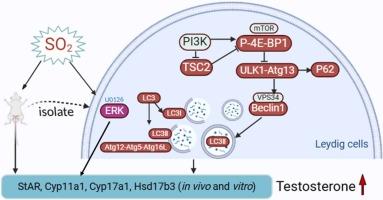二氧化硫通过激活ERK1/2通路和破坏间质细胞的自噬来增加睾酮的生物合成
IF 11.3
1区 环境科学与生态学
Q1 ENGINEERING, ENVIRONMENTAL
引用次数: 0
摘要
二氧化硫(SO2)是一种普遍存在的环境污染物,已被证明对男性生殖系统有毒,但其潜在机制尚不清楚。因此,我们建立SO2处理小鼠和原代间质细胞模型,研究SO2对睾酮产生的影响及其具体机制。结果表明,SO2激活ERK1/2信号通路,导致睾酮生物合成关键蛋白表达增加,睾酮水平升高。ERK1/2抑制剂U0126的加入减弱了二氧化硫诱导的关键睾酮生物合成基因Star、Cyp17a1、Hsd3b1和睾酮mRNA水平的升高。低剂量SO2降低了间质细胞BECLIN1和LC3蛋白的表达,增加了P-4E-BP1蛋白的表达,减少了自噬。此外,增加SO2剂量最初与间质细胞自噬和睾酮水平增强相关。然而,增加SO2的剂量导致细胞活力显著下降,并最终降低睾酮水平。这些发现表明SO2通过激活ERK1/2和破坏自噬来促进睾酮的产生。本研究丰富了SO2对男性生殖系统的量效关系,为我们全面、动态地了解SO2的毒性机制提供了理论参考。本文章由计算机程序翻译,如有差异,请以英文原文为准。

Sulfur dioxide increases testosterone biosynthesis by activating ERK1/2 pathway and disrupting autophagy in Leydig cells
Sulfur dioxide (SO2) is a ubiquitous environmental pollutant that has been shown to be toxic to the male reproductive system, but the underlying mechanism remains unclear. Therefore, the SO2-treated mice and primary Leydig cell models were established to investigate the effects of SO2 on the production of testosterone and its specific mechanism. The results demonstrated that SO2 activated the ERK1/2 signaling pathway, leading to increased key proteins expression of testosterone biosynthesis and elevated testosterone levels. The addition of ERK1/2 inhibitor U0126 attenuated SO2-induced increases in key testosterone biosynthetic gene mRNA levels of Star, Cyp17a1, Hsd3b1, and testosterone. Low doses of SO2 reduced the expression of BECLIN1 and LC3 proteins, increased P-4E-BP1 protein expression, and decreased autophagy in Leydig cells. Moreover, increasing doses of SO2 correlate with enhanced Leydig cell autophagy and testosterone levels initially. However, increasing the dose of SO2 resulted in a significant decrease in cell viability and ultimately decreased testosterone levels. These findings suggest that SO2 promotes testosterone production by activating ERK1/2 and disrupting autophagy. This study enriched the dose-effect relationship of SO2 on the male reproductive system and provided a theoretical reference for us to have a comprehensive and dynamic understanding of the SO2 toxic mechanism.
求助全文
通过发布文献求助,成功后即可免费获取论文全文。
去求助
来源期刊

Journal of Hazardous Materials
工程技术-工程:环境
CiteScore
25.40
自引率
5.90%
发文量
3059
审稿时长
58 days
期刊介绍:
The Journal of Hazardous Materials serves as a global platform for promoting cutting-edge research in the field of Environmental Science and Engineering. Our publication features a wide range of articles, including full-length research papers, review articles, and perspectives, with the aim of enhancing our understanding of the dangers and risks associated with various materials concerning public health and the environment. It is important to note that the term "environmental contaminants" refers specifically to substances that pose hazardous effects through contamination, while excluding those that do not have such impacts on the environment or human health. Moreover, we emphasize the distinction between wastes and hazardous materials in order to provide further clarity on the scope of the journal. We have a keen interest in exploring specific compounds and microbial agents that have adverse effects on the environment.
 求助内容:
求助内容: 应助结果提醒方式:
应助结果提醒方式:


